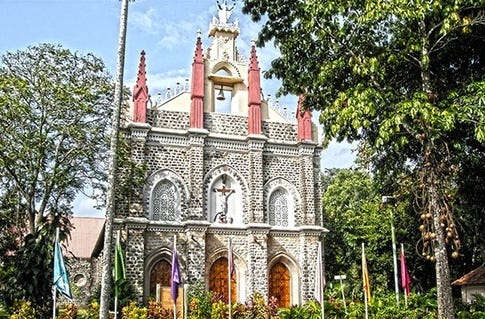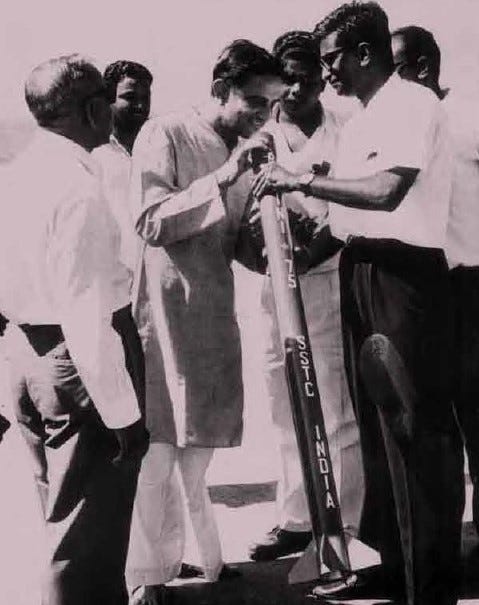The Remarkable Story of the Beginning of Indian Space Programme
Revisit the beginning of Indian Space Programme (ISRO) as it happened on 21st November 1963 with the first Sounding Rocket Launch from TERLS, Thumba.
An evening in November 1963, Members of the Legislative Assembly (MLAs) of Kerala suspended a running session to come out for twenty minutes to look at the sky and witness the Beginning of the Indian Space Programme (ISRO).
PRL - The Cradle of Space Sciences
Let us go back a few years. Dr Vikram Sarabhai founded the Physical Research Laboratory (PRL) at the M.G. Science College Ahemdabad. Research on cosmic ray studies was conducted by eminent scientists such as E. V. Chitnis. Dr Sarabhai himself sat only on a table at the end of a corridor. Despite a meagre start, the laboratory invited many lectures from many scientists. Even Nobel Laureate S Chandrashekar inspired the students and faculty there. Many scientists from PRL visited NASA, MIT, Harvard and many recognised institutions and acquired knowledge in the space background. Within a few years, PRL gained recognition in the science world and became the cradle of the Indian Space Programme.
Search for a Sounding Rocket Site
In around 1961, Dr Sarabhai started thinking of a space programme. INCOSPAR (Indian Indian National Committee for Space Research) was created as an autonomous body under the Department of Atomic Energy in February 1962. In July, the search of the site for a sounding rocket was conducted. Prof. E V Chintis decided Thumba to be the most suitable place after considering the Magnetic Equator and safety of fishers around the region.
I went in July 1962 in search of the site. We had several rounds of searches and the Kerala government cooperated extremely well. Bhabha himself came for final site selection. We stayed with the Governor at his guest house and a fleet of fifteen cars was available to go for site inspection. Bhabha, Sarabhai, Goveas, Chief Architect R.B. Patel and I – all five of us stayed as guests of Governor V.V. Giri and he hosted a dinner for us. So we had no difficulty in approaching anybody. INCOSPAR was working as an organisation.
C V Chintis (An excerpt from the book From Fishing Hamlet to Red Planet)
The locality was inhabited around a beautiful church, St. Mary Magdalene Church. Dr Sarabhai met the Bishop and requested for transfer of property. He was asked by the Bishop to meet on Sunday during the morning service. Dr APJ Abdul Kalam beautifully describes the congregation on Sunday in his book Ignited Minds.
The church has been converted to a space museum. The following link can help to plan a visit: https://www.vssc.gov.in/VSSC/index.php/outreach/space-measeum-visit-request.
Cold War Enemies Come Together
Within 100 days, the fishermen were relocated around a newly built church. NASA, the Soviet Union and CNES came together to help prepare the rocket range. The USA provided the rocket. The Minsk gave a computer while a helicopter came from USSR. The payload for the rocket-based experiment, known as the sodium vapour payload, was personally brought by Prof. Jacques Blamont from France, who has recently (2015) been honoured with a Padma Shri by the Government of India. This was the personality of Dr Sarabhai that the cold-war enemies together assisted for the beginning of the Indian Space Programme.
Many things also went awry. The hydraulic crane malfunction, therefore, the rocket was shifted into the position manually. The payload and rocket were incompatible. Consequently, a very young engineer spent the night working with a file to fit the payload within the Nose Cone. The engineer was none other than our beloved ex-president Dr APJ Abdul Kalam.
Beginning of Indian Space Programme
After all this hard work, at 6:25 PM, the Nike Apache Rocket sailed through the sky creating a sodium cloud and beginning the Indian Space Programme. The orange cloud, visible to the naked eye created a lot of interest. Even the Legislative Assembly of Kerala was suspended for 20 minutes to observe the phenomena. As described by Prof. Jacques Blamont, a child was born on 21 November 1963, and we watch its achievements with admirations (today).
Read more about the beginning of the Indian Space Programme.



